Announcing Windows 11 Insider Preview Build 22557
Hello Windows Insiders, today we are releasing Windows 11 Insider Preview Build 22557 to the Dev Channel.
TL;DR
- Windows Insiders will notice that the name of the branch we are releasing builds from has changed to NI_RELEASE. The branch in which we release builds from to Insiders in the Dev Channel is irrelevant to the features and improvements included within them. Going forward we will no longer be noting when these branch changes occur. For more on our approach to how we release things to the Dev Channel, please read this blog post here.
- This build will not be offered to ARM64 PCs. We hope to be able to offer a new build for Insiders on ARM64 PCs soon.
- This build includes a handful of new features for Insiders to try including folders in the pinned apps area of Start, live captions, a new Focus experience, Quick Access improvements in File Explorer, new touch gestures, and a lot more.
- This build also includes a lot of general improvements and refinements to Windows 11 too.
- We do have some new known issues for some of the new features and improvements being introduced with this build so be sure to read through the known issues below before submitting feedback.
- We’re making it quicker to get to your recent Android apps on your phone from the Your Phone app. Details below.
- Join us on Tuesday, February 22nd at 10am PST / 6pm UTC for our next Windows Insider webcast! We’ll discuss “Filing Feedback on the Difficult Bugs”, we’ll talk about logs that can be helpful, and sharing content links you can reference. Mark your calendar and tune in!
What’s new in Build 22557
Create and curate folders in the pinned apps area of Start
We’ve heard from many of you that you’d like to customize your pins in Start by organizing them into folders, so we’re introducing the first version of folders in this build. Simply drag an app on top of another to create a folder. You can add more apps to a folder, rearrange apps within a folder, and remove apps from a folder. Keep an eye out for further improvements like the ability to name and rename folders in one of our upcoming builds.
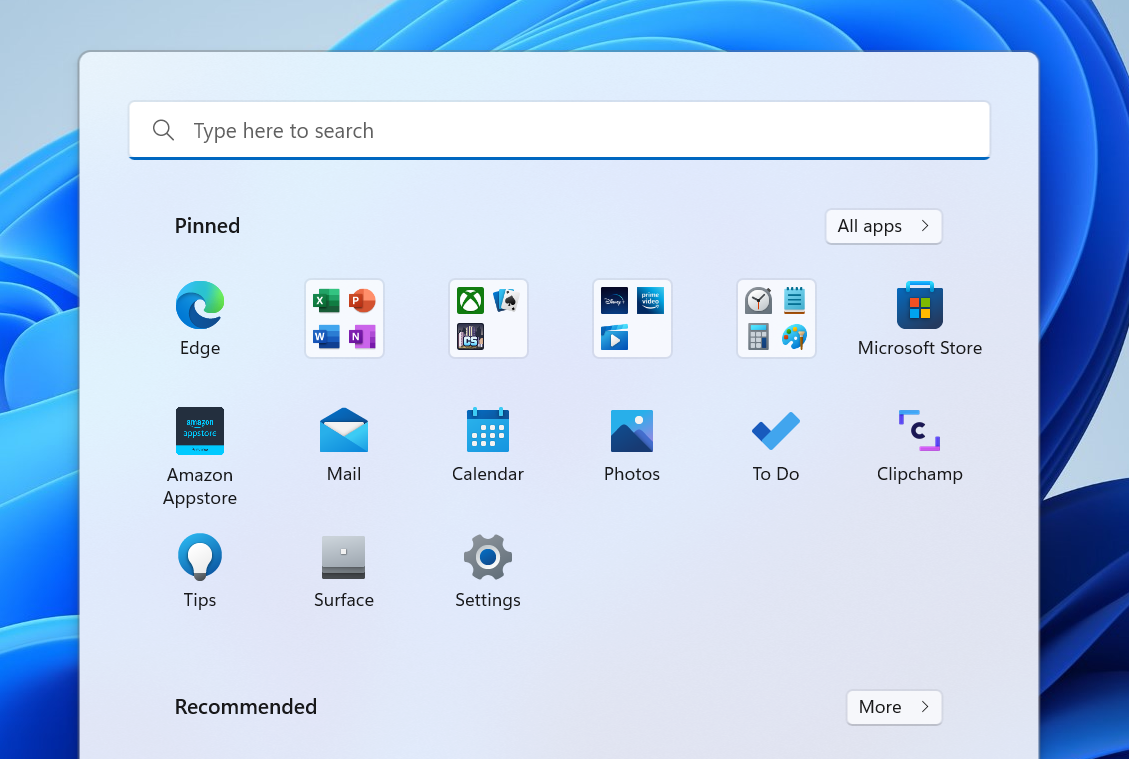
FEEDBACK: Please file feedback in Feedback Hub (WIN + F) under Desktop Environment > Start menu.
Introducing Do Not Disturb and Focus
We’ve reimagined focus experiences on Windows. Do not disturb makes it easy to silence notifications. Focus is a new experience that enables everyone to stay in the moment and minimize distractions on their PC. To help you stay on track, focus integrates with the Clock app for other focus tools, such as a focus timer and calming music.
Do not disturb:
It’s now easier than ever to silence notification banners with do not disturb. When you are ready to see the notifications that you may have missed, you can find them in Notification Center.
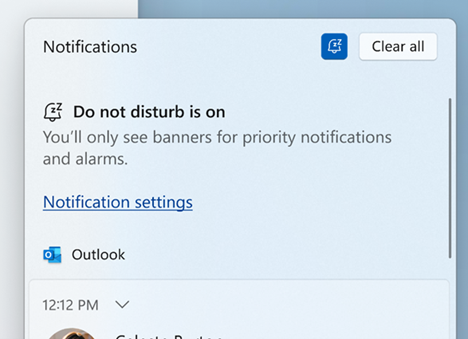
You are always in control of your notifications. Under Settings > System > Notifications, you can set up rules to automatically turn on do not disturb. For example, you could set do not disturb to automatically turn on outside of your work hours. Additionally, you can set priority notifications to control whether calls, reminders, and specific apps break through when do not disturb is on.
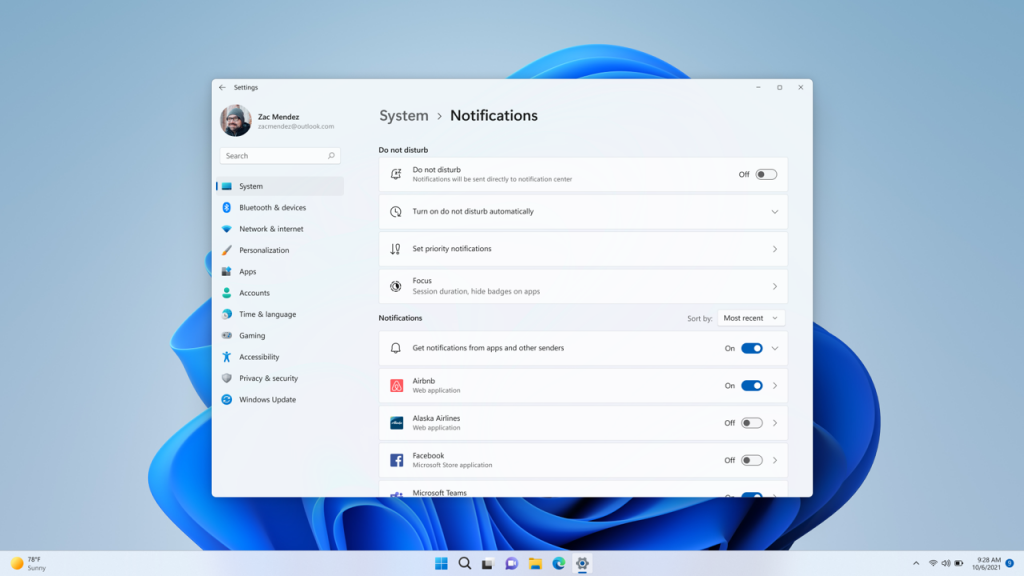
Focus:
It is easy to start focus right from Notification Center (click on the time and date in the taskbar):
- Open Notification Center.
- Select the amount of time for your focus session.
- Press Start Focus.
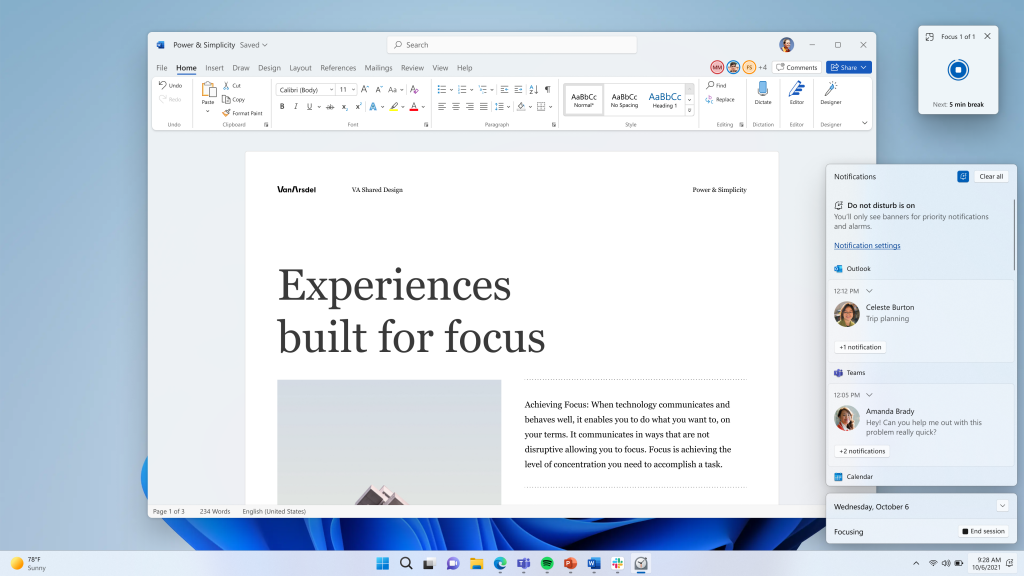
When you start a focus session, taskbar badging will turn off, flashing of applications in the taskbar will turn off, a focus timer will appear on screen, and do not disturb will turn on. Focus in Windows integrates with focus sessions in the Clock app, so you can play calming music and see a task list from Microsoft To-Do. When your focus session ends, you will receive a notification letting you know your focus time has completed. You can personalize your focus experience (Settings > System > Focus).
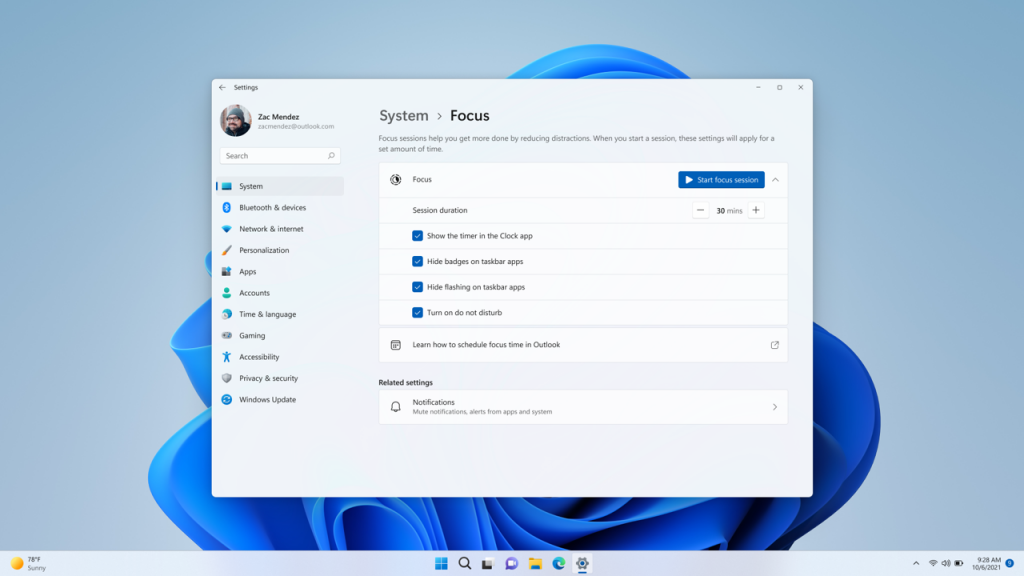
FEEDBACK: Please file feedback in Feedback Hub (WIN + F) under Desktop Environment > Focus.
Live Captions
Live captions will help everyone, including people who are deaf or hard of hearing, better understand audio by viewing captions of spoken content. Captions are automatically generated on-device from any content with audio. Captions can be displayed at the top or bottom of the screen, or in a floating window. The caption window can be resized, and caption appearance can be personalized by applying or customizing a caption style. Microphone audio can be included, which can be helpful during in-person conversations. Live captions support English (U.S.) content.

To get started, live captions can be turned on with the WIN + Ctrl + L keyboard shortcut, or from the Accessibility flyout under Quick Settings. When turned on the first time, live captions will prompt for download of the required speech model to enable on-device captioning.
FEEDBACK: Please file feedback in Feedback Hub (WIN + F) under Accessibility > Live captions.
Improving Quick Access in File Explorer
We are rolling out an update to File Explorer’s Quick Access view. First, “Pin to Quick Access” support has been extended from only supporting Folders to now also supporting Files. Pinned files are shown in a new section above Recent files in Quick Access.

Next, for users who log into Windows with (or attach as a secondary account) a Microsoft Account or Work/Education account, Pinned and Recent files from Office.com will also be shown in Quick Access. Changes that pin or unpin files hosted in OneDrive, SharePoint, and Teams will sync and be reflected in Office.com and Office apps. File activity updates from collaborators such as edits, and comments are shown in Tiles view and can also be shown in Details view.
FEEDBACK: Please file feedback in Feedback Hub (WIN + F) under Files, Folders, and Online Storage > File Explorer.
See your OneDrive storage in File Explorer
Backing up your files and managing your cloud storage is important for the safety of your stuff. To help you have control over storage consumption and ensure your files are syncing, we’ve added OneDrive integration into File Explorer. When browsing your OneDrive folders, you can now see your sync status and quota usage without having to leave File Explorer.

ALT-TEXT: OneDrive storage as shown in File Explorer when navigating to OneDrive folders.
FEEDBACK: Please file feedback in Feedback Hub (WIN + F) under Files, Folders, and Online Storage > File Explorer.
New Touch Gestures
This build includes 5 new touch gestures to make it easier and quicker to navigate Windows 11 on a PC with touch:
Swipe to invoke and dismiss Start: Swipe with your finger from the middle of the taskbar to invoke the Start menu and swipe back down to dismiss it.
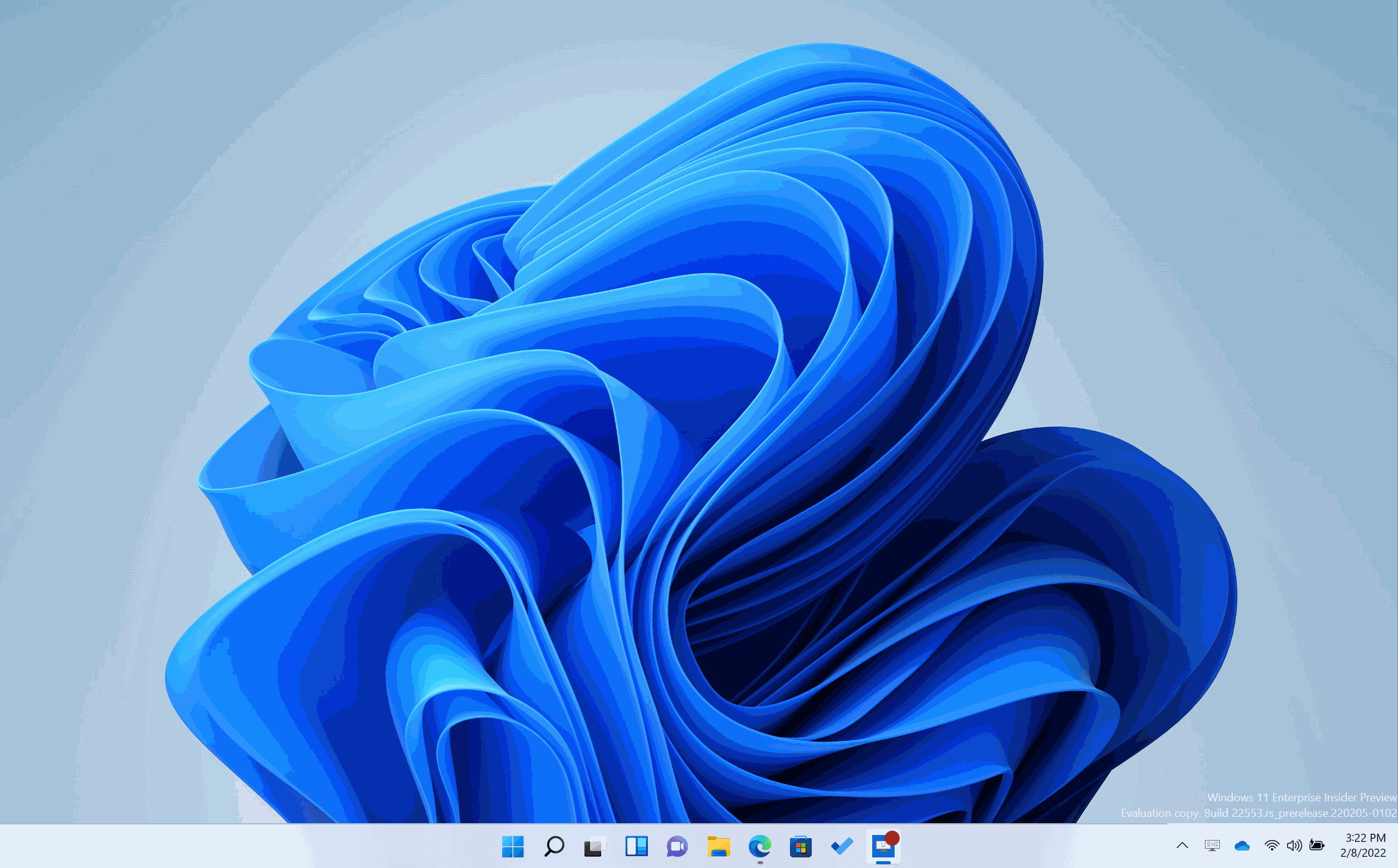
Swipe between Pinned/All apps and Recommended/More on Start: Within Start, swipe right to left from Pinned to get to All apps and left to right to get back to Pinned. The same gesture works for Recommended/More.
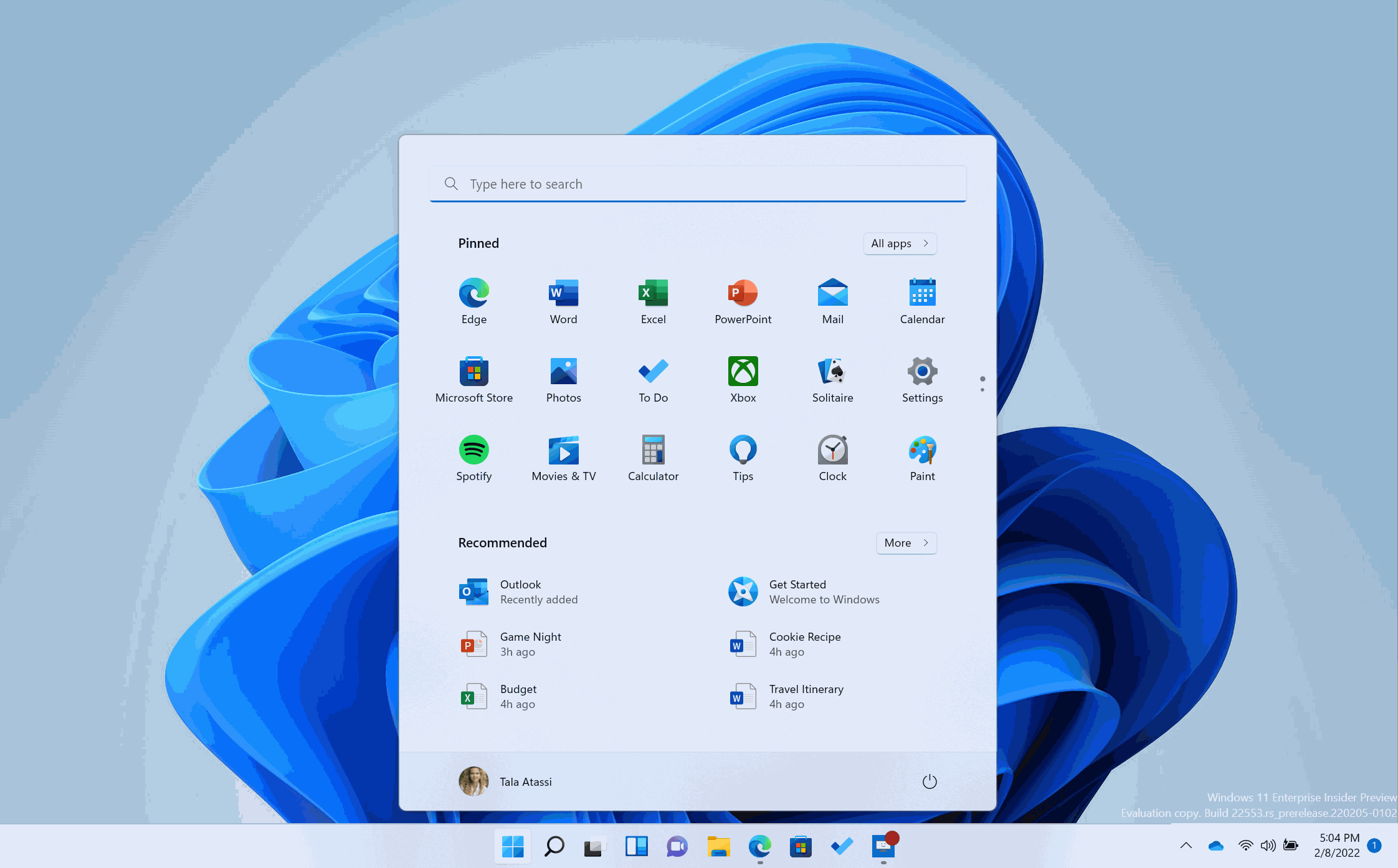
Swipe to invoke and dismiss Quick Settings: Swipe with your finger from the bottom right of the taskbar to invoke Quick Settings and swipe back down to dismiss it.
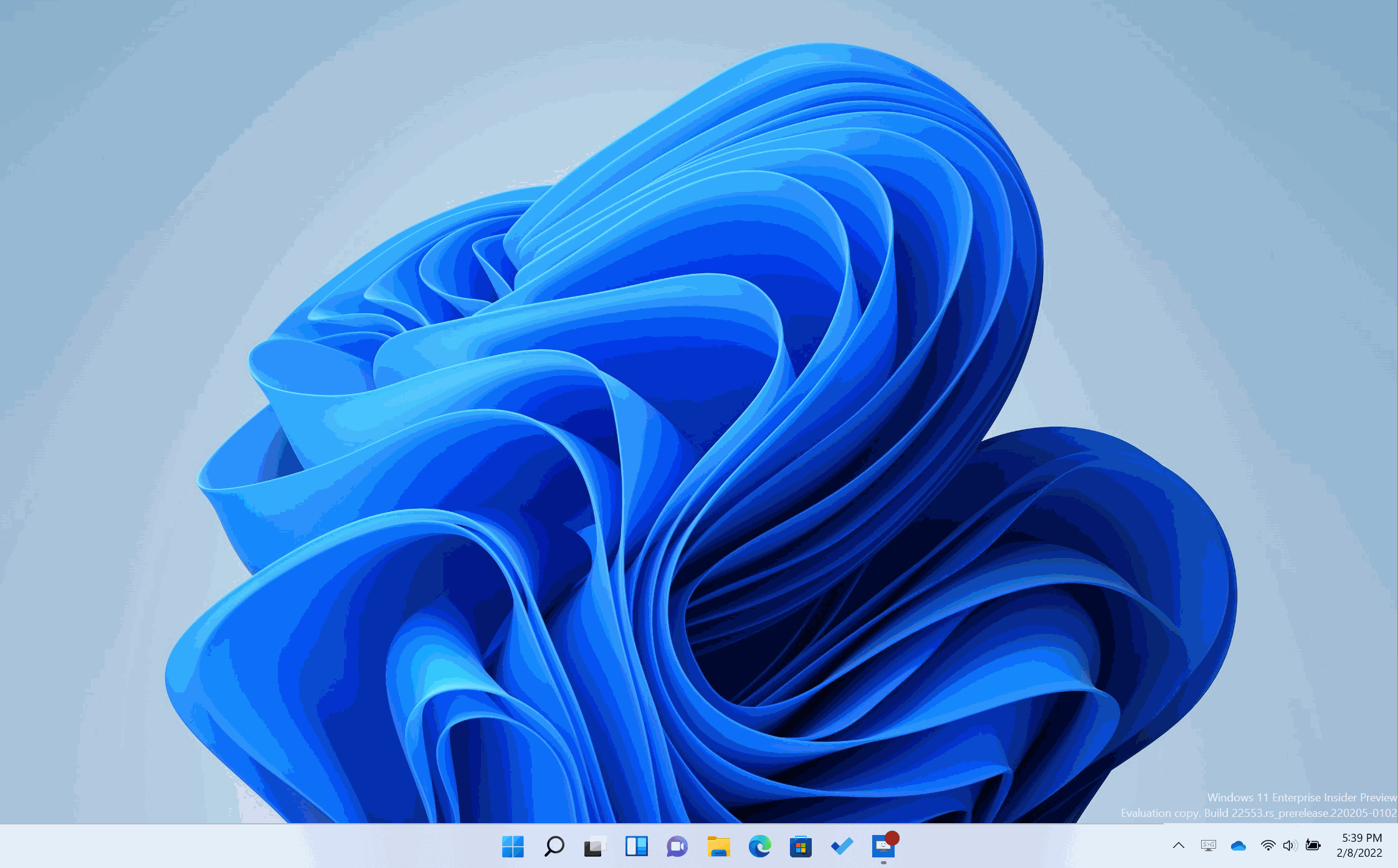
Swipe to invoke and dismiss Notification Center: We’ve updated the animation when swiping to invoke and dismiss Notification Center from the right edge of your screen so that it’s more responsive and follows your finger.
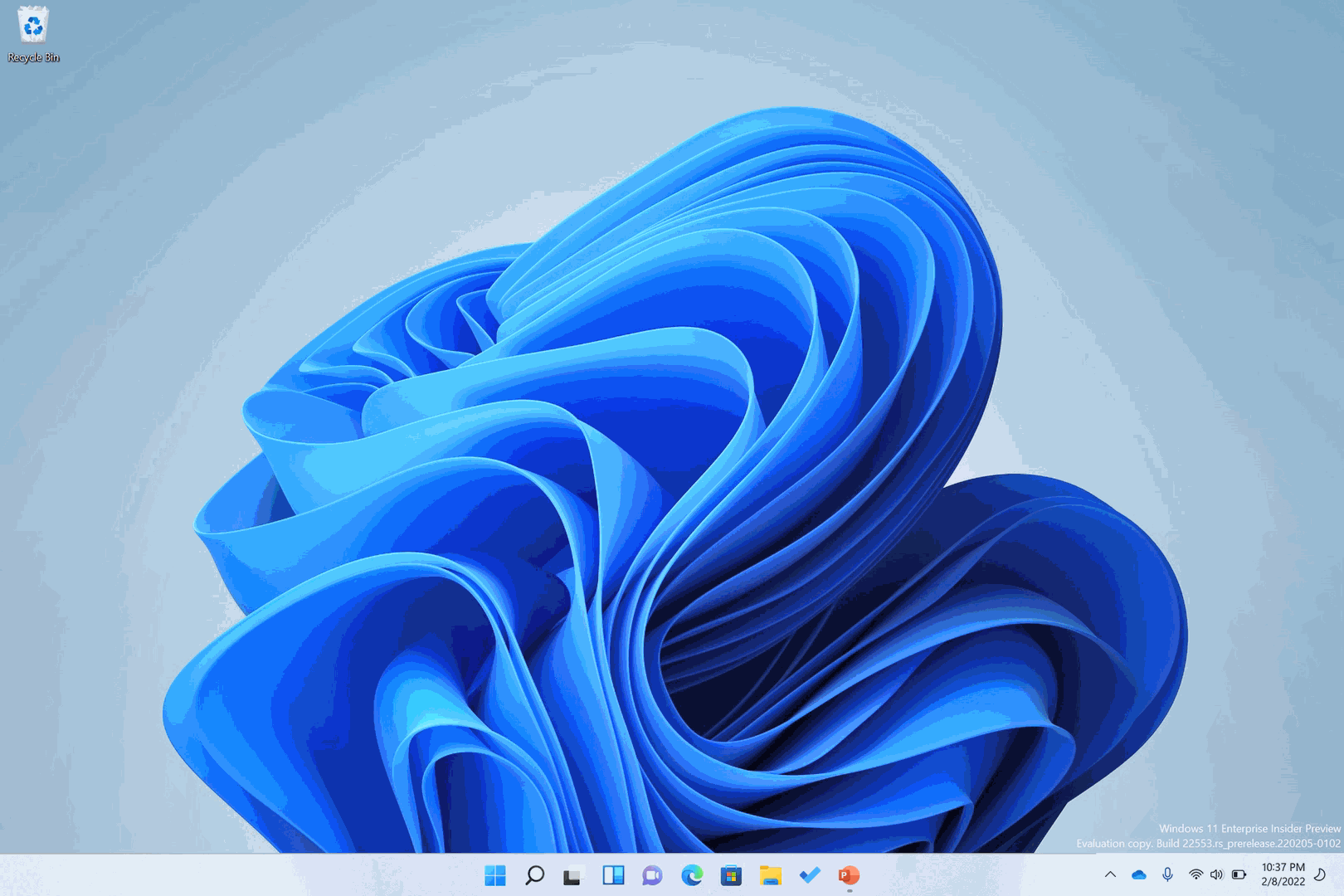
Full screen gripper: In full screen touch-oriented apps and games (e.g., Solitaire), notice a gripper that appears if you swipe from the edges of the screen. This feature is designed to keep you in your app if you accidentally swipe near the edges. If you need to access edge content, simply swipe again on the gripper.
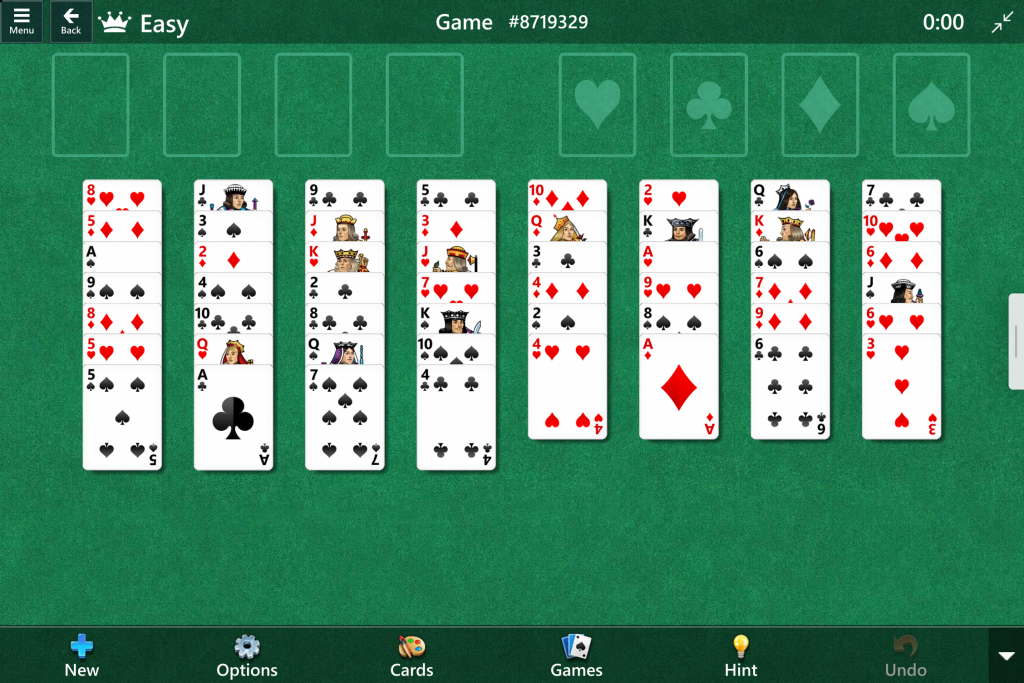
Note that these gestures are reversed in Right to Left languages. Any swipe from the right becomes a swipe from the left and vice versa.
FEEDBACK: Please file feedback in Feedback Hub (WIN + F) under Input and Language > Touch Input and Gestures.
Improving Snap Layouts
We’ve added a new way to snap windows into snap layouts that works wonderfully with both touch and mouse! To try it out, just drag a window to the top of the screen to reveal the snap layouts, drop the window on top of a zone to snap it, and use snap assist to finish building your layout.
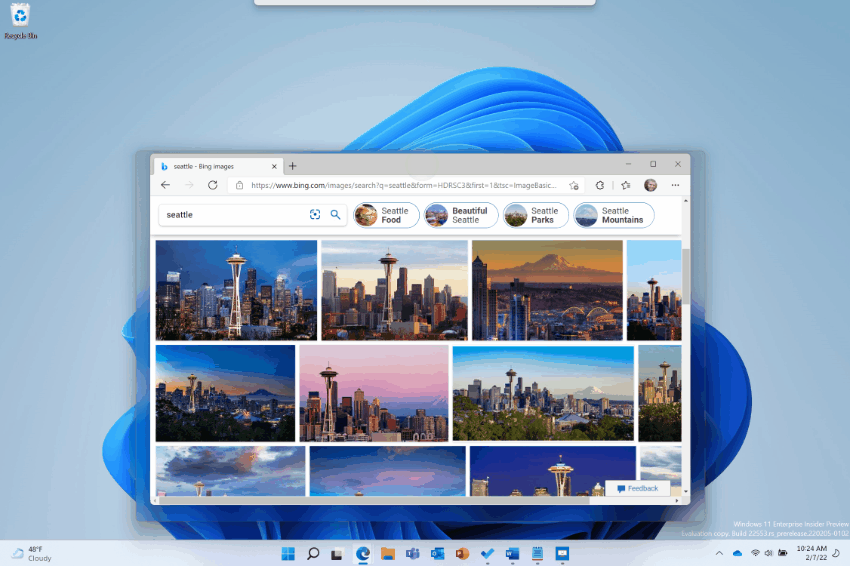
On top of all that, we’ve also improved snap assist to seamlessly animate between zones in a layout for a delightful end-to-end snapping experience.
FEEDBACK: Please file feedback in Feedback Hub (WIN + F) under Desktop Environment > Snap.
More sustainable power settings and recommendations
The default values for Sleep and Screen off have been updated to reduce energy consumption, and carbon emissions, when PCs are idle. We will also provide power saving recommendations to help reduce carbon emissions to those with Sleep and Screen off set to Never.
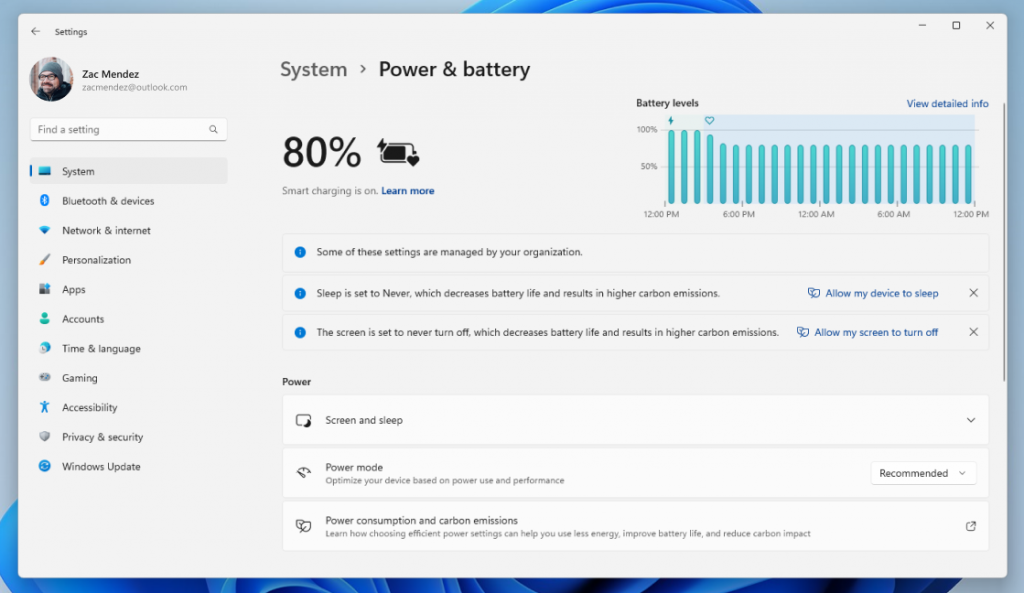
The changes to default Sleep and Screen off settings will only be seen by those clean-installing Windows 11 with this build or higher. If you intentionally set Sleep or Screen off to Never, please let us know why, especially if sleep is not working as expected. We’re still working on the content that the “Power consumption and carbon emissions” options links to – stay tuned for future updates.
FEEDBACK: Please file feedback in Feedback Hub (WIN + F) under Power and Sleep > Sleep (or use the link above).
More improvements to browsing the web in Microsoft Edge with Narrator
Building off the collection of improvements for Narrator and Microsoft Edge from Build 22509, we have been working on more improvements to web browsing with Microsoft Edge and Narrator. Specifically, when navigating the web more useful information is provided, navigating dialogs is more natural, and editing text should now be more reliable.
When navigating the web, you can have Narrator read the current item (e.g., current page, current time etc.) and when you need to sort a table on the web, Narrator will announce the sort order you’ve selected (e.g., ascending, descending).
We also made it simpler to know when an item is selected in a tree view control and to know the state of a checkbox when these are part of a list. We also improved link navigation, and you will find that tabbing through links on a webpage and pressing Enter will always take you to the link destination.
When you encounter a dialog box on the web, Narrator will help you stay focused within the dialog box and prevent navigation to the content that’s behind it. This improvement is currently available in Microsoft Edge Canary builds.
Lastly Narrator has a few improvements for when you are editing text on the web. First, if you are deleting text on a form field, Narrator will read the character that was deleted and if you need to cut a large set of text with Control + X, Narrator will confirm that the text has been cut.
FEEDBACK: Please file feedback in Feedback Hub (WIN + F) under Accessibility > Narrator.
Task Manager Redesign & Efficiency Mode
We have updated the design of Task Manager to match the new Windows 11 design principles. This includes a new hamburger style navigation bar and a new settings page. A new command bar on each page gives access to common actions. We are also excited to bring dark theme to Task manager and will automatically match the system-wide theme configured in the Settings app.
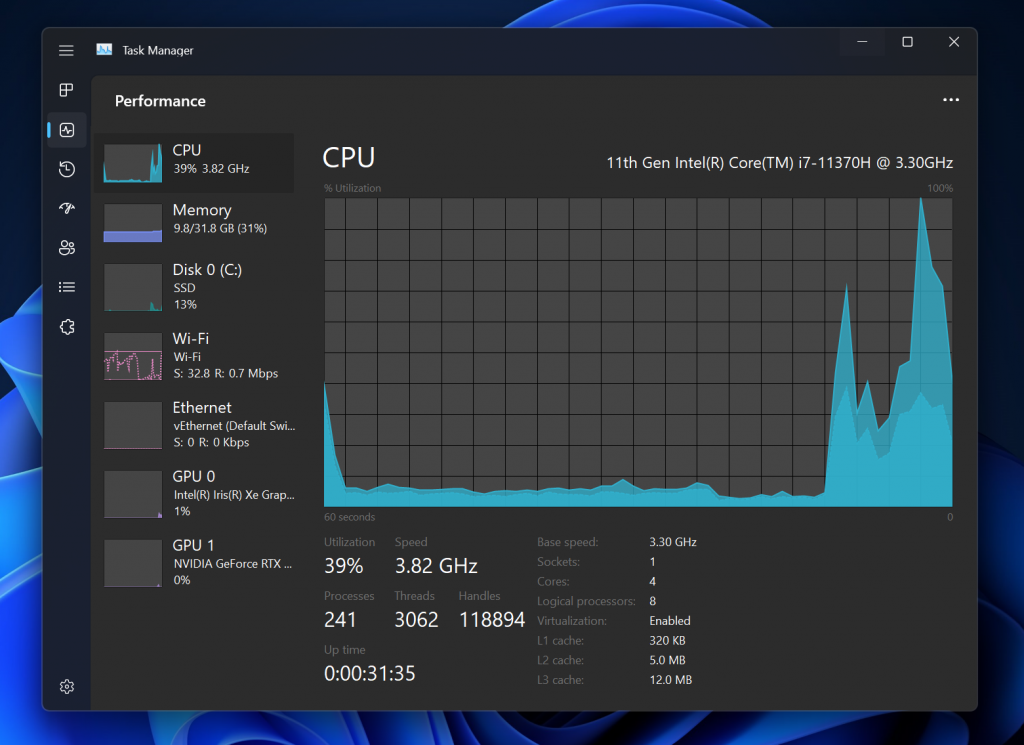
Last April, we experimented with a new feature called “Eco mode” in Task Manager and we’re bringing this back with a new brand name: Efficiency mode. This feature is helpful when you notice an app consuming high resources and would like to limit its consumption so that the system gives priority to other apps which will lead to faster foreground responsiveness and better energy efficiency.
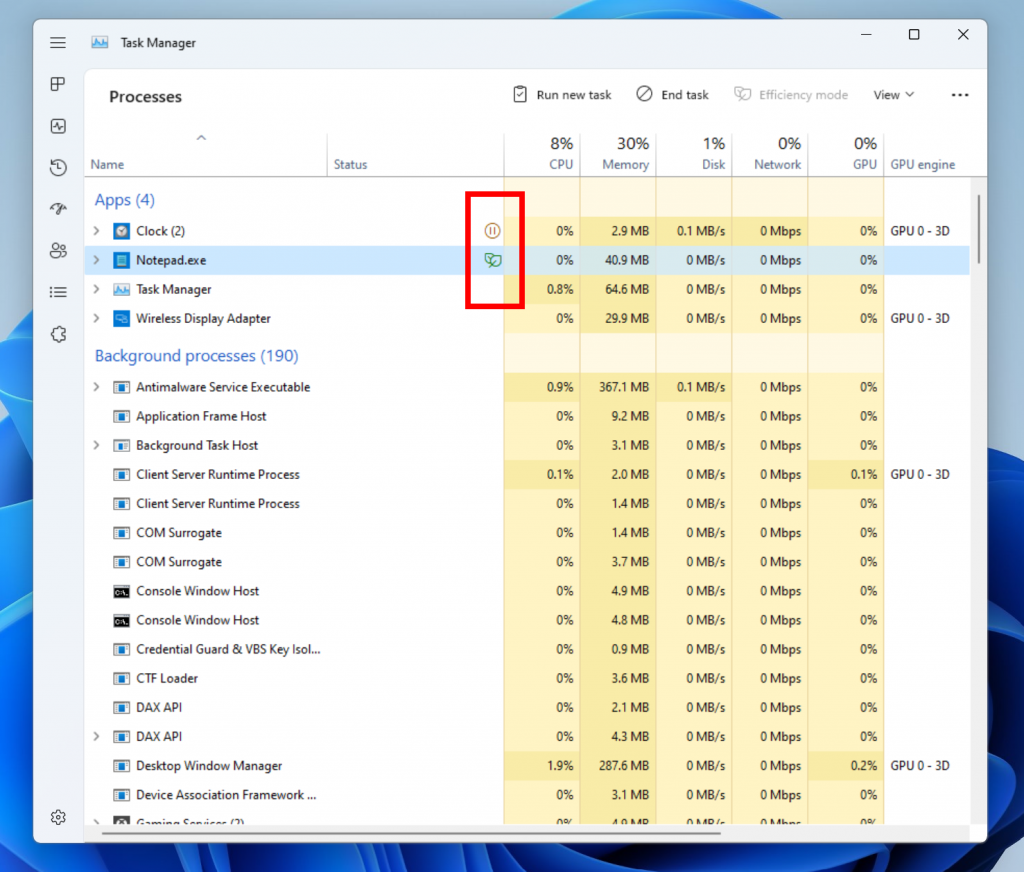
You can apply Efficiency mode either by clicking on the command bar in the Processes page or right click on the process. You can only apply Efficiency mode to single process and not to the entire group process. If the option is grey out, it generally means that it’s a core Windows process and throttling it might affect the performance of the system. The Efficiency mode process will be marked with a new leaf icon, and we are also introducing new pause icon for Suspended process to indicate the process is in suspended mode
[We are beginning to roll this change out, so it isn’t available to all Insiders just yet as we plan to monitor feedback and see how it lands before pushing it out to everyone.]
FEEDBACK: Please file feedback in Feedback Hub (WIN + F) under Desktop Environment > Task Manager.
Introducing a new PowerShell module to provision language and language related features
This new PowerShell Module allows users to easily add languages and related language features and manage settings like System Preferred UI Language, System Locale, Input method (Keyboard), Locale, Speech Recognizer, User Preferred Language List using the PowerShell prompt. These commands work in conjunction with the existing International PowerShell Module to provide the user control over various elements of the UI language on a PC.
Note: To run the Install and Set commands you must run PowerShell as an administrator.
| To do this | Command |
| Install a language on the PC. | Install-Language
Note: Please restart or log out and log back in for changes to take effect. Once you log back in, please change your Windows display language (WDL) via Settings > Time & language > Language & region to change the UI language on the PC. You can also change your WDL by using the international module commands (Set-WinUILanguageOverride ). Params: Language: The bcp47 tag of the language being installed. CopyToSettings (optional): If included, set the system and default device settings (WDL, regional, locale format) to the provided language following the installation. |
| Get a list of the installed languages on the device, which type of Language Pack is installed, and what Language Features are installed. | Get-InstalledLanguage
Alias: Get-Language Params: Language (optional): filters the list to only show the given language. |
| Set a language as the System Preferred UI Language | Set-SystemPreferredUILanguage
Alias: Set-PreferredLanguage, Set-SystemLanguage Params: Language: The bcp47 tag of the language being installed |
| Get the value of the current System Preferred Language. | Get-SystemPreferredUILanguage
Note: Please restart or log out and log back to see the changes reflected in the new language. Additional user accounts created on the same system will reflect the new system language. Alias: Get-PreferredLanguage , Get-SystemLanguage |
| Uninstall a language on the PC. | Uninstall-Language
Params: Language: The bcp47 tag of the language being installed. |
FEEDBACK: Please file feedback in Feedback Hub (WIN + F) under Apps > PowerShell.
Changes and Improvements
[Taskbar]
- Drag and drop is now supported on the Windows 11 taskbar. Quickly drag and drop files between app windows, by hovering over apps in the taskbar to bring their windows to the foreground. Try attaching a file to an Outlook e-mail by dragging it and hovering over the Outlook icon in the taskbar to bring the window to the foreground. Once in the foreground, drop your file into the e-mail to attach it. You can also customize your taskbar with your favorite apps from Start’s All apps list by dragging and dropping over the taskbar to pin them. You can also drag and drop to the desktop via “Show desktop” at the very right corner of the taskbar.
- For Insiders using Microsoft Teams for work and school that are using share any window from the taskbar, we have added a new visual indication to the taskbar that indicates which window is being shared. This is especially important when you have multiple applications running or where your attention is split across multiple monitors. When you choose to share a window in your Microsoft Teams call, the shared window will also now be surrounded by a colored border.

- On PC’s with more than one color profile, you will be able to add a quick setting to switch more easily between these modes. On clean install, the Color profile button should not be pinned by default, but it might appear on upgrades.
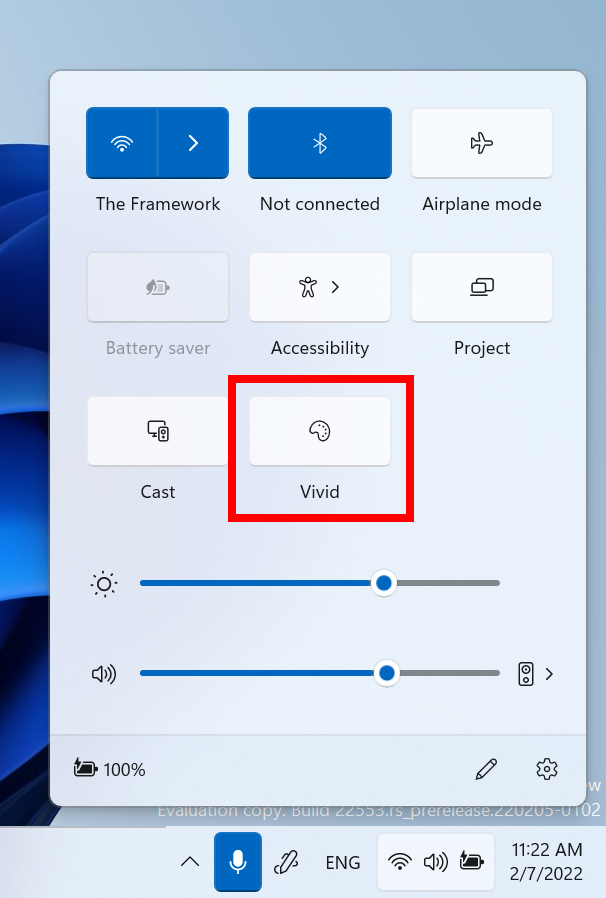
- When casting (WIN + K) from your PC, a Cast icon will appear at the lower-left corner of your taskbar to show you are casting. Clicking the icon will open the Cast Quick Settings where you can quickly stop casting if needed. And expect more improvements coming for this experience.
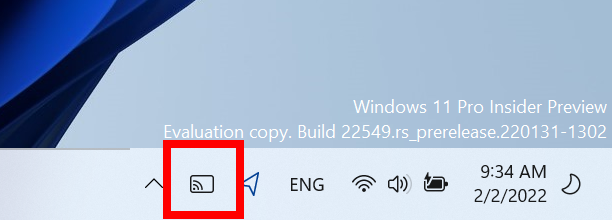
- As discovered by Insiders with Build 22543, we have updated the battery charging indicator to use a lightning bolt instead of a power cable. This addresses feedback that it was not possible to see lower charging levels at-a-glance because they were obscured by the cable. It’s also consistent with other consumer electronics devices and reflects the evolving landscape of charging to include USB charging devices.

[File Explorer]
- File Explorer will now show previews of items within folders.

- When sharing a local file in File Explorer to Outlook – you can now compose an email message directly within the share window without having to go into Outlook directly. You will need Outlook Desktop Integration installed via the Store and this capability is not available for files stored in OneDrive folders as OneDrive has its own share experience. Also, the share window will now suggest contacts from Microsoft 365 to share the file to via Outlook.
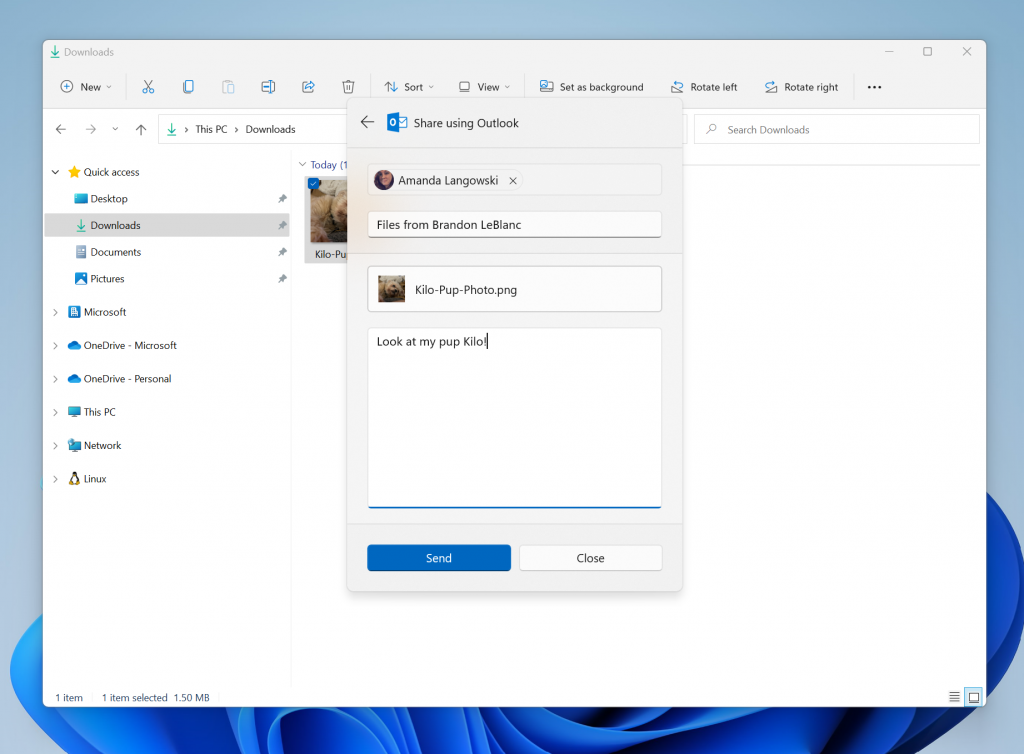
[Search]
- Searching for apps and settings in the Windows search box on the taskbar is now even faster and more accurate than before. Try searching for your favorite app or a setting you use frequently to see faster results. We’ve also fixed an issue that prevented Windows users from being able to search for an app in the first few seconds after it had been installed.
[Windowing]
- We have updated the snap group visuals to include the desktop wallpaper to make it easier to differentiate your groups from normal windows. This will appear when using ALT + TAB, Task View, and in the taskbar previews. Additionally, ALT + TAB will now show as windowed for all Insiders running Build 22554 and up.
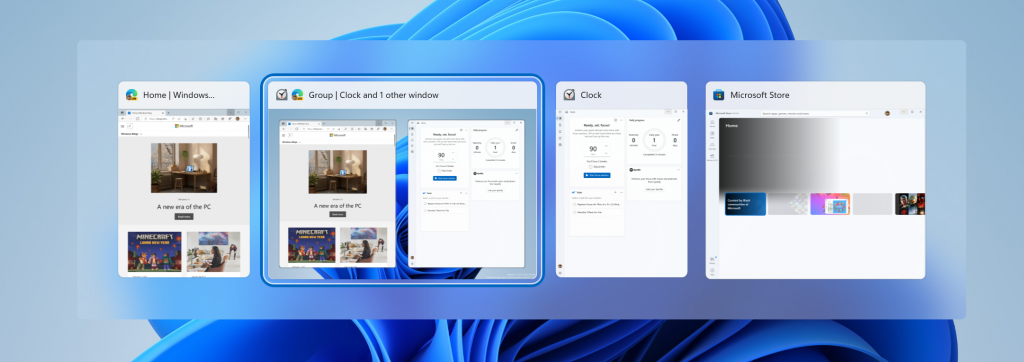
- We are updating the transition animation that shows going from one snapped window state to another. Snap some windows using the snap assist, move windows from one configuration to another and observe the fluidity of the transition with our new animations.

- Rotating your device between portrait and landscape orientation is snappier, more responsive.

- We have reduced the number of notification sounds that play when you connect and disconnect docks and monitors.
- It is now easier to move your cursor and windows between monitors, by letting your cursor jump over areas where it would previously get stuck. This behavior is controlled in settings with System > Display > Multiple displays > Ease cursor movement between displays.
- We’ve made some small changes to the snapping options under System > Multitasking to help simplify them and make them easier to understand.
[Narrator]
- Narrator now provides a new male natural voice called Guy. We introduced new natural voices for Narrator in Build 22543.
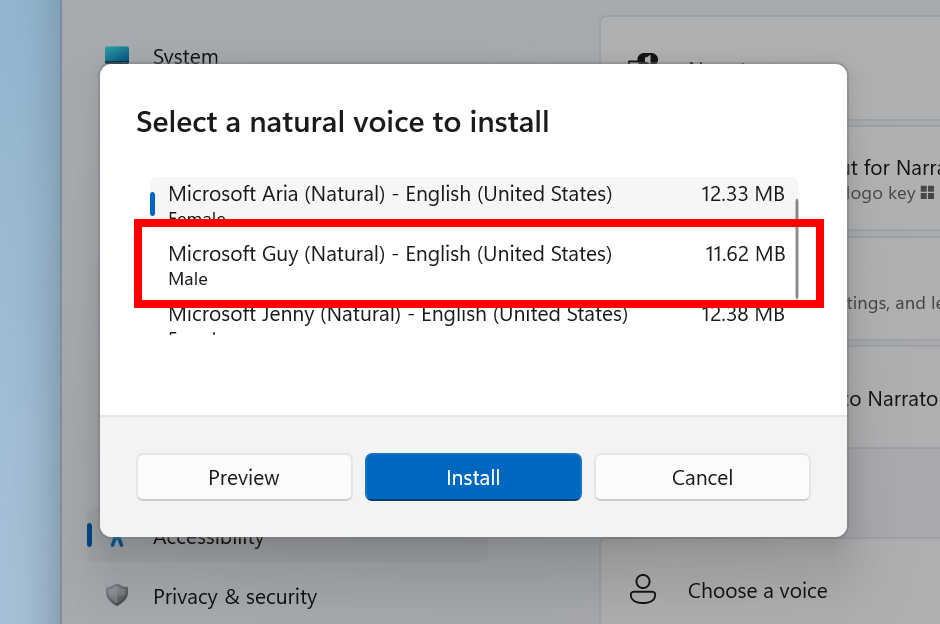
[Voice typing]
- We are adding the ability for you to choose which microphone to use in voice typing if you have multiple microphones connected to your PC. [We are beginning to roll this change out, so it isn’t available to all Insiders just yet as we plan to monitor feedback before pushing it out to everyone.]
- We are beginning to roll out the ability for you to use the following new commands in voice typing. [We are beginning to roll this change out, so it isn’t available to all Insiders just yet as we plan to monitor feedback before pushing it out to everyone.]
| To insert this | Say this |
| Enter | “Press Enter” |
| Backspace | “Pres Backspace”, “Backspace” |
| Space | “Press space”, “Insert Space” |
| Tab | “Press Tab”, “Tab” |
[Voice access]
- A new setting to add punctuation automatically when dictating text has been added. You can turn it on by clicking on the settings icon on voice access UI and selecting automatic punctuation from “manage options”.
- We added a new setting to filter profanity. This is on by default and any profane or sensitive words will be masked with asterisk (*) when dictating text or commanding. You can turn it off by clicking on the settings icon on voice access UI and selecting filter profanity from “manage options”.
- It is now easier to use “show numbers” command as we have reduced the occurrence of number labels hiding the controls on windows UI and making it hard to understand the control under a number.
- We improved feedback messages for unsupported languages.
- We also improved feedback messages for using voice access when you have multiple displays setup.
- We improved discoverability of using touch keyboard with voice to enter passwords or PINs, correcting mistakes, and spelling out words using “correct that” and “spell that” commands.
| To do this | Say this |
| Correct the last dictated text | “Correct that”, “Spell that” |
| Correct specific text | “Correct [text]”, “Spell [text]” |
[Graphics]
- We’re expanding Dynamic Refresh Rate (DRR) experiences on laptops with 120Hz displays beyond smooth scrolling in Office and low latency inking. When you move the cursor, the system will now boost to 120Hz, making your PC feel more responsive. Touch and pen interactions blend into smooth animations in Windows UI and apps UI. Smooth scrolling is now supported not only in Office, but also in Microsoft Edge Canary and Windows UI such as the Settings app. To enable smooth scrolling on Edge Canary you need to enter the following in the address bar of a new tab: “edge://flags/#edge-refresh-rate-boost-on-scroll”, set the highlighted flag to ‘Enabled’ and then restart Edge.
- The Windows HDR Calibration app is coming to Windows PCs soon – you’ll be able to improve color accuracy and consistency on your HDR display. For easier access, you’ll be able to access this app via the Windows settings under System > Display > HDR You may see an early access point in HDR settings in this build, but as the app is not live yet, it will simply lead you here.
- This build introduces a feature called Optimizations for windowed games and is designed to significantly improve latency and unlock other exciting gaming features including Auto HDR and Variable Refresh Rate (VRR). Latency improvements can benefit all gamers – from improving your input lag to creating a competitive edge in your gaming experience. Go to System > Display > Graphics > Change default graphics settings to enable the feature. Note that this feature may be already on by default and is also required to use other graphics features such as Auto HDR. To learn more, check out https://aka.ms/WindowedGameOptimizations.
[Input]
- We’re working on adding an IME On/Off key to the touch keyboard small layout for the Japanese, Korean, and Chinese Traditional IMEs. For Insiders with only one keyboard this will be a standalone key on the left of the space key. If you have multiple keyboards the On/Off key is combined with voice typing – to access voice typing, simply press and hold the key. In addition, we’re adding small layout support for the Chinese Simplified Microsoft Pinyin and Microsoft Wubi IMEs. These changes are currently rolling out to a subset of Windows Insiders at first and we’ll expand over time based on feedback.
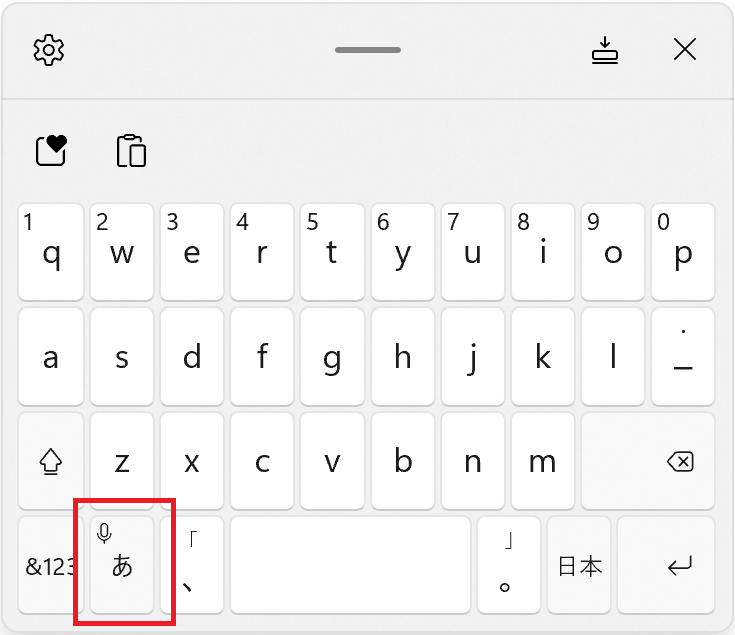
- Updated some of the emoji based on feedback, including the smile with tear emoji, sakura emoji, and colored heart emojis.
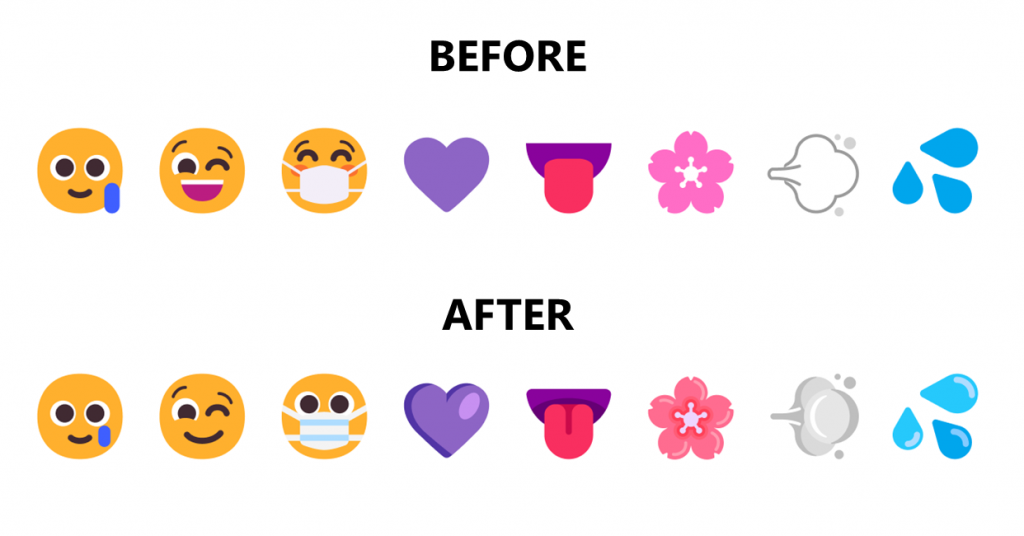
- Added a few new items to the kaomoji section in WIN + Period(.) based on feedback, including UwU.
- Windows 11 now supports Hungarian for handwriting input as of this build. Pick up your pen and write using Hungarian in the handwriting input panel or handwriting keyboard, and have your handwriting be converted to text.
[Settings]
- We’ve done some work to generally improve results when searching in Settings, including more relevant results and now have some flexibility for returning results in the case when the search terms have common typos.
- We’ve increased the size of the icons in the Settings navigation pane to make them a bit easier to see.
- To help customers give their PC a second life, or recycle it, we are including links in Settings to help customers find available programs. Some articles may not be localized.
- Storage Sense will now be enabled by default for PCs going through OOBE. Your current settings will be persisted on upgrade. You can configure your Storage Sense settings under System > Storage.
- Updated Settings Time & Language category and Date & time page to now include a live digital clock and information about currently selected option.
- Updated the design of Network & Internet > Dial-up when you have a connection set up to align with the overall design of Settings in Windows 11.
- We’ve made some adjustments to Personalization > Fonts to improve the design of the page, including that the drag and drop area for installing fonts is larger now.
[Windows Sandbox]
- Aligning with Hyper-V behavior, even if you’re not in full screen mode, modifier keys and shortcuts (for example Windows key shortcut) will now be intercepted by Windows Sandbox if the window has focus.
- Windows Sandbox now supports basic environment variable usage (like %USERPROFILE%) inside in mapped folder paths.
[Other changes]
- We have updated the accessibility flyout on the login screen to align with Windows 11 design principles.
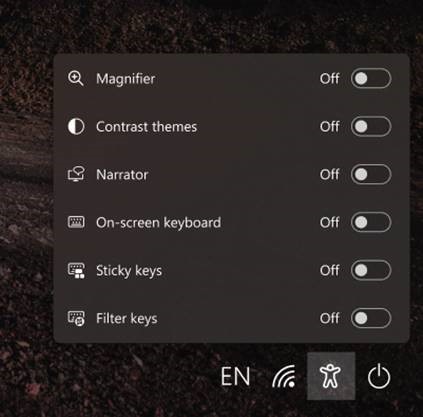
- Insiders will notice the Mica material in more title bar surfaces. For example, the Run dialog now utilizes Mica.

- TKIP and WEP are deprecated security standards and Windows 11 will no longer allow connections to those types starting with this build. Contact your network administrator or update your router to one that supports at least WPA2 (WPA3 is the current standard).
- Similar to Windows 11 Home edition, Windows 11 Pro edition now requires internet connectivity during the initial device setup (OOBE) only. If you choose to setup device for personal use, MSA will be required for setup as well. You can expect Microsoft Account to be required in subsequent WIP flights.
Fixes
[General]
- Fixed a recurring backgroundTaskHost.exe some Insiders were experiencing.
- Fixed an issue leading to auto HDR not activating as expected in certain games.
- Mitigated an lsass.exe crash that was resulting in some Insiders seeing crashes on the login screen in recent flights.
- Addressed an issue that was leading to noticeably distorted audio for audio devices connected using the Xbox Wireless Adapter in recent flights.
[Taskbar]
- Task View should no longer crash if you hold CTRL while hovering over it.
- Dragging a file across the taskbar on secondary monitors should no longer cause an explorer.exe crash.
[File Explorer]
- Updated the Storage Usage button in the Properties dialog for a disk to now be called Details and a little wider, to accommodate for languages where the button text was getting truncated.
- Improved the performance of deleting files in Recycle Bin.
- Fixed the Blu-ray icon so it aligns with the other drive and volume icons.
[Input]
- Addressed an issue where the IME candidate window was unexpectedly not following your preference of light or dark mode.
- Fixed an issue leading to some elements of the voice typing settings flyout to be invisible in dark mode.
- The IME candidate window should appear as expected now in the username field of a UAC prompt.
- Updated the term “Halfwidth alphanumeric / Direct Input” to just say “Halfwidth Alphanumeric” in the Japanese IME context menu.
- Fixed an issue where after typing hiragana in Kana-input mode if there was a half-width alphabet character before the hiragana in composition it would unexpectedly become full-width.
- Addressed a rare issue where the input switcher might unexpectedly list the same entry twice.
- Mitigated an issue leading to an unexpected black box that was appearing in the input switcher sometimes.
- Updated the input switcher so it can get a bit taller now for people with more than 4 keyboards.
- Fixed a memory leak in the input switcher leading to explorer.exe crashing after repeated rapid use.
- Fixed an explorer.exe crash when clicking on More Keyboard Settings in the input switcher.
- Fixed an issue where the emoji panel might show “you’re offline” even though you had network connectivity.
- Fixed an issue where the multiply emoji and counterclockwise arrows button emoji were displaying the design for the wrong emoji.
- Updated the preview in the Personalization > Text input Settings page to reflect your desktop wallpaper rather than the default.
- Did some work to improve reliability of the Stop media key when media is playing.
[Voice access]
- We fixed a Visual C++ Runtime mismatch causing voice access to not run on some PCs.
[Search]
- Fixed a high hitting search crash.
- Clicking the search box in Start will now immediately switch over to Search without showing the Search window animate in upwards, just like when you press the Windows key and start to type.
[Settings]
- Addressed an issue where Narrator wasn’t reading the elements of System > Storage correctly.
- Fixed the broken “size and theme” link under Time & Language > Typing > Touch keyboard.
- Did some work to help improve performance when updating accent color or mode.
- We made a change to help reduce clipping in combo boxes in Settings for certain languages and text sizes.
- Fixed an issue that was causing the icons on the IME settings pages to sometimes be white on white.
- Mitigated an issue leading to the install button having truncated text in some languages when previewing fonts.
- Fixed an underlying crash that was causing the preview video on System > Display > HDR to be distorted sometimes.
- Addressed an underlying issue that could make Settings crash when you scrolled the window.
- Adjusted the Wi-Fi icon in the Wi-Fi section of Quick Settings so that the lock shown for a secured network now has a small separation from the Wi-Fi strength, making it a bit easier to distinguish.
[Windows Spotlight]
- Updated the name of Spotlight collection to be Windows Spotlight, so it’s consistent with the Lock screen.
- Made a change to help make Windows Spotlight update images more reliably.
- Rather than showing a solid color background, if for some reason new Windows Spotlight images aren’t available for the desktop, it will now fall back to showing the default Windows Spotlight background image (Whitehaven Beach).
- Right-clicking on “Learn more about this picture” for Windows Spotlight on the desktop will now always show all options, just greyed out if they’re not currently available.
- When hovering over “Learn more about this picture”, the tooltip should now more consistently align with the current image.
[Windowing]
- Addressed an issue that was causing the minimize, maximize, and close buttons in File Explorer and some other apps to be invisible in certain cases.
- Mitigated an issue leading to performance impact when dragging windows with acrylic and other scenarios with acrylic.
- You should no longer see a briefly visible yellow border when taking screenshots.
- We’ve made some improvements to address feedback that windows were repositioning unexpectedly.
[Network]
- Did some work to address an issue that might cause certain VPN connections to fail. If you continue experiencing issues, please file feedback with a capture of the issue under Network and Internet > Connecting with a VPN client.
- Fixed an issue that was leading to decreased Wi-Fi speeds after waking your PC from sleep in the previous flight.
[Narrator]
- When backspacing, Narrator will now more consistently announce when you’re deleting characters with backspace.
- Fixed an issue causing Narrator not to read selected text in the Feedback Hub.
NOTE: Some fixes noted here in Insider Preview builds from the active development branch may make their way into the servicing updates for the released version of Windows 11 that became generally available on October 5th, 2021.
Known issues
[General]
- When going through the device setup experience (OOBE) on the Enterprise edition, the network add screen will be skipped on the first attempt. As a workaround, when users see the “name your computer” option, please reboot and re-start OOBE. The network add screen will now appear as expected.
[Start]
- Names of apps in folders may appear blurred briefly when opening folders in Start.
[Taskbar]
- The taskbar will sometimes flicker when switching input methods.
[File Explorer]
- Searches from Quick Access may not work.
- We’re working fixing issues regarding icon sizing, visual bugs, and text clipping in the flyout showing OneDrive storage.
[Focus]
- The taskbar icon and tooltip may not match the focus state.
- Clock app integration requires an app update that is starting to become available today. Most users should get this update automatically, but you can check for app updates manually by navigating to Microsoft Store > Library and clicking Get updates.
- The Clock app does not yet update Windows Focus state when configuring focus sessions within the app. This will be addressed in a future app update.
[Search]
- After clicking the Search icon on the Taskbar, the Search panel may not open. If this occurs, restart the “Windows Explorer” process, and open the search panel again.
[Widgets]
- With the taskbar left-aligned, information such as temperature is not shown. This will be fixed in a future update.
[Live captions]
- Certain apps in full screen (e.g., video players) prevent live captions from being visible.
- Certain apps positioned near the top of the screen and closed before live captions is run will re-launch behind the live captions window positioned at top. Use the system menu (ALT + Spacebar) while the app has focus to move the app’s window further down.
- The very top of maximized apps (e.g., title bar window management buttons) can’t be reached with touch while live captions is positioned at the top.
[Task Manager]
- We are aware that the Efficiency mode icon is missing on some child processes.
- Some settings options are not preserved.
- We are working on fixing issues regarding icon size, visual bugs and in most cases the workaround is to either resize Task Manager or lower the resolution settings from Settings > Display > Display resolution.
- Task Manager has limited keyboard support in navigation and command bar. Users may unable to navigate the UI using the keyboard due to limited support.
For developers
You can download the latest Windows Insider SDK at aka.ms/windowsinsidersdk.
SDK NuGet packages are now also flighting at NuGet Gallery | WindowsSDK which include:
- .NET TFM packages for use in .NET apps as described at ms/windowsinsidersdk
- C++ packages for Win32 headers and libs per architecture
- BuildTools package when you just need tools like MakeAppx.exe, MakePri.exe, and SignTool.exe
These NuGet packages provide more granular access to the SDK and better integrate in CI/CD pipelines.
Your Phone app: Get to your recent Android apps faster
We are excited to announce another feature for the Your Phone app. For those of you with Samsung devices, now you can enjoy more continuity as you move from your phone to your PC. With this latest addition, you can easily access recently used apps from your Android device on your Windows PC.
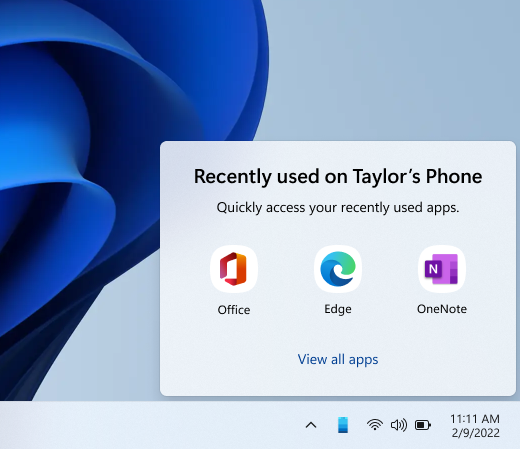
You can access the three most recently used apps from your Android by selecting the Your Phone icon in the Windows taskbar. You can also find a new recent apps section within the apps page in Your Phone app. The feature is now available for all Windows Insiders in all Insider channels with select Samsung devices (details below). Give it a try and let us know what you think!
Recent Apps requirements:
To use recent apps, you will need:
- Your Phone app version 1.21092.145.0 or higher. Older versions will not show recent apps even if you have a supported device.
- A supported Android device. Recent Apps requires a deeper level of integration with the Android device and the team worked directly with Samsung to light this up. It is available on select Samsung devices that have Link to Windows, with OneUI 3.1.1 or higher and Link to Windows Service 2.3 or higher, such as:
- Samsung Galaxy Z Fold
- Samsung Galaxy Z Flip
- Samsung Galaxy S series
- Samsung Galaxy Note series
- Your Android device and PC need to be connected to the same Wi-Fi network for apps to launch on your PC.
About the Dev Channel [Updated!]
The Dev Channel receives builds that represent long lead work from our engineers with features and experiences that may never get released as we try out different concepts and get feedback. It is important to remember that the builds we release to the Dev Channel should not be seen as matched to any specific release of Windows and the features included may change over time, be removed, or replaced in Insider builds or may never be released beyond Windows Insiders to general customers. For more information, please read this blog post about how we plan to use the Dev Channel to incubate new ideas, work on long lead items, and control the states of individual features.
These aren’t always stable builds, and sometimes you will see issues that block key activities or require workarounds. It is important to make sure you read the known issues listed in our blog posts as we document many of these issues with each flight.
Build numbers are higher in the Dev Channel than the Windows 11 preview builds in the Beta and Release Preview Channels. You will not be able to switch from the Dev Channel to the Beta or Release Preview Channels without doing a clean install back to the released version of Windows 11 currently.
The desktop watermark you see at the lower right corner of your desktop is normal for these pre-release builds.
Important Insider Links
- Want to learn how we made Windows 11? Check out our Inside Windows 11 website to hear and meet our makers from Engineering, Design and Research to share their insights and unique perspectives throughout this journey.
- You can check out our Windows Insider Program documentation here, including a list of all the new features and updates released in builds so far.
- Check out Flight Hub for a complete look at what build is in which Insider channel.
Thanks,
Amanda & Brandon
EDITOR’S NOTE: We updated the bullet regarding the internet requirement in the device setup experience (OOBE) for the Windows 11 Pro edition.
